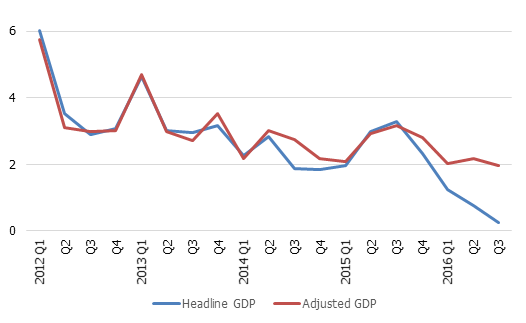Macroeconomic balance maintained in 2016, supply side should be strengthened in 2017
For Latvijas Banka Monthly Newsletter, In Focus, December, 2016

The growth of Latvia's GDP by about 1.0% in 2016 was the slowest in six years. The delayed absorption of EU funds plunged the Latvian economy into a technical recession, with gross capital formation and construction both losing about 20% of the previous year's bulk. At a first glance it seems that the Latvian economy is totally dependent on the inflow of EU funds. In reality, however, this reflects a temporary level effect. If in the next year the EU funds remain as low as in 2016, the drag on growth will be removed and GDP dynamics will recover. In turn, if EU funds resume in line with our expectations, their impact on the growth rate will turn positive, and the GDP dynamics is even more likely to recover. Thus, the temporary nature of 2016 slowdown makes it hardly an appropriate reason to worry about. The adjusted GDP [1] growth rate slightly exceeded 2% in 2016 (see Figure 1). The real challenge is how to accelerate potential GDP growth further, as 2% growth would imply slow if any convergence.
Currently, the economy of Latvia is close to macroeconomic equilibrium, with the output gap and the unemployment gap both near zero. The deceleration of GDP growth in 2016 didn't have a strong impact on businesses' medium-term expectations, otherwise enterprises would have reduced the number of their employees. In reality, the labour market continued to improve, with unemployment rate stabilising at one-digit level and currently standing below the euro area average. Crucially, the reason for unemployment decreases is not the long-term unemployed becoming discouraged and disappearing from unemployment statistics: the number of discouraged workers is consistently declining and participation rate is at a historically high level above the EU average. Both industrial production and overall exports exceed historical maximums, with the share of Latvian exports in global trade also climbing up.
The formerly steep wage growth has substantially decelerated, favourably impacting Latvia's competitiveness. A wage rise exceeding labour productivity (partly driven by a solid minimum wage rise) would not be sustainable in the long run. Moreover, the current situation when wages are reacting elastically to the output dynamics is an additional argument in favour of economy being quite close to macroeconomic balance. Thus, instead of worrying about a temporary 2016 slowdown we should focus on supply-side economics and implement the necessary structural reforms in public institutions, education, healthcare to boost potential GDP growth and to foster income convergence with Western Europe. A very accommodative monetary policy may provide a short-term relief but cannot accelerate potential GDP growth if slow growth is a result of structural problems.
Figure 1. Headline and adjusted real GDP growth (year-on-year; %)

[1] From the official GDP figure I excluded several construction segments that are heavily dependent on EU fund inflows and administrative decisions (civil engineering structures like roads, bridges and power lines as well as some non-residential buildings like schools, libraries and hospitals).
Textual error
«… …»






